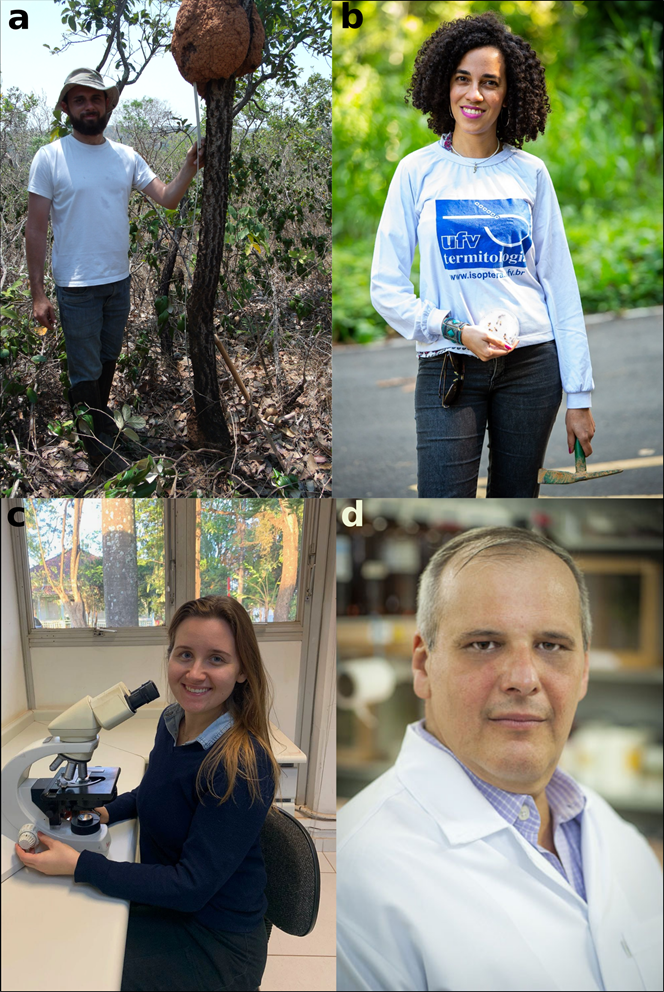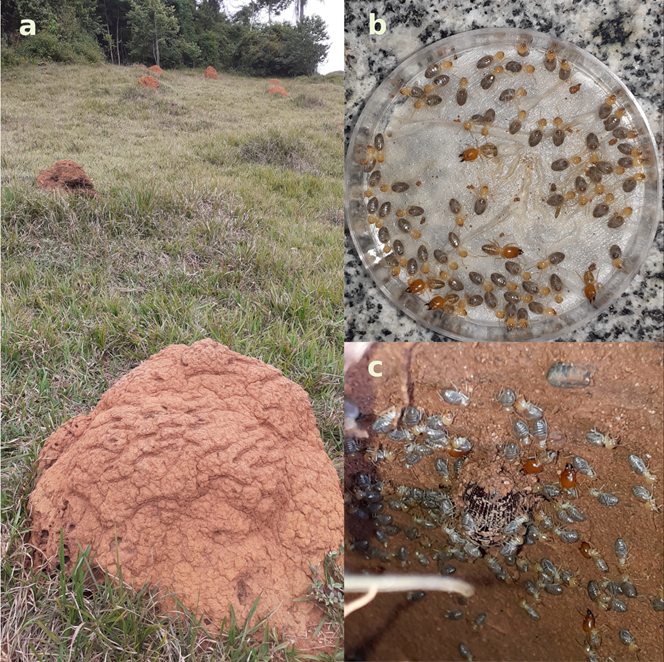By Raul M. Pisno
Pisno’s study, together with his colleagues Dinamarta V. Ferreira, Julia J. Ferla and José E. Serrão tested whether mite population growth is dependent on termite mortality. Their results indicate that termite mortality favors the increase of Australhypopus sp. populations. The paper can be found here.
Termites are recognized as ecosystem engineers since they modify the environment to obtain resources as food and nests components. Their nests are environments favorable to housing other organisms that interact indirectly (e.g., lichens that grow on the walls of termites) or directly, as in the case of termitophiles.
Termitophiles are organisms, mostly arthropods that must spend at least one stage of their lifespan inside the termite nest. These organisms have morphological, behavioral, or physiological adaptations that allow the coexistence with the hosts inside the nests. Flies (Phoridae) and beetles (Staphylinidae), for instance, present an enlargement of the abdomen, resulting in a body shape similar to termites.
Most of the termitophiles have small populations inside the host nests, making their ecological relationships a fascinating enigma since termite nests have controlled and uniform environmental conditions. Therefore, when we discovered a mite that rapidly increased its population, associated with a termite, we had a rare opportunity to study the ecological relationships between them.
The discovery of the mite and its ability to rapidly increase its population was unplanned. We collected nest fragments of the termite Cornitermes cumulans (Kollar 1832) (Blattodea; Isoptera: Termitidae) for other objectives. However, we found that some individuals had one or two mites attached to their body, mainly on the head. We sent some to the acarology laboratory at the Federal University of Viçosa, and it was discovered that it was actually a new species!
As time passed, the colonies kept in the laboratory weakened and the number of mites attached to the termites increased. At this point, we asked ourselves: Does the increase in the mite population weaken the termite population, or is the mite population increasing because the termites are dying?

Fig. 1 The team of researchers: a Raul M. Pisno; b Dinamarta V. Ferreira; c Julia J. Ferla; d José E. Serrão
First, we looked for an answer in the literature but found only very little concerning this subject. So we designed a setup to answer our question and simultaneously describe the relationship of the new species with its host. We made a new collection of termite nest fragments. They were kept in the laboratory for 15 days for periodic sampling to count mites and for survival analysis. On day 15, when colonies were weakened and the mite population had increased, we collected samples to test whether mite development depended on termite mortality.
The results did not come as a surprise, but it was fascinating to describe an unusual relationship. The mite remains in an immature stage stuck to the termite body, without feeding, until the host dies. Only then does the mite proceed with its development to complete its life cycle, including reproduction, while feeding on the carcass of the termite.
The discovery and description of this fascinating relationship, summarized in these few lines above, may have important implications for studying ecological and evolutionary relationships in social insects! If we look at the mite relationship from the point of view of the termites individually, we would have a commensal relationship; at the host colony level, we would have a mutualistic relationship, since the mite may provide a hygienic service by rapidly feeding on carcasses before microorganisms and harmful organisms infect the colony.

Fig. 2 a Nests of the termite Cornitermes cumulans in the field; b petri dish with termites for mite count; c termites burying a beetle next to their nest in the field
From an evolutionary point of view, the mechanism used by mites to recognize the host as a corpse and then continue its development is only possible through a long evolutionary pathway, showing the importance of termites in the evolution of other species. If we look at the number of species that have developed some adaptation to be able to live with termites, we might recognize termites not just as ecosystem but as biodiversity engineers.